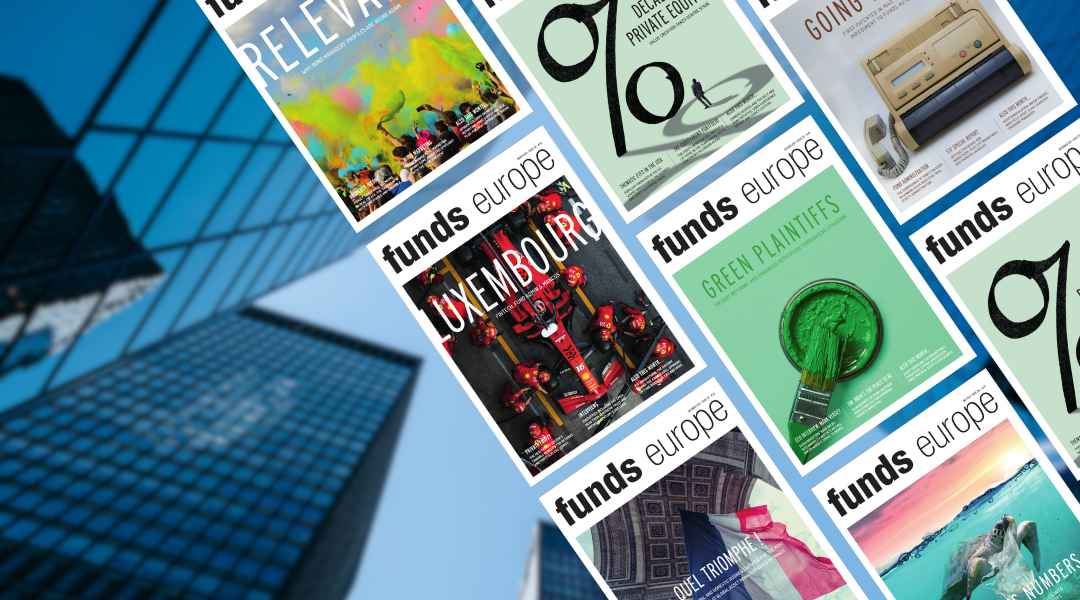 Threadneedle has high expectations of the Asian market. Nick Fitzpatrick talks to William Lowndes, Asia head, about the firmâs route to market.
Threadneedle, the London-based fund manager, expects to have doubled its Asia-based staff by the end of the year following the arrival of William Lowndes to Hong Kong in April to expand the operation.
Threadneedle has high expectations of the Asian market. Nick Fitzpatrick talks to William Lowndes, Asia head, about the firmâs route to market.
Threadneedle, the London-based fund manager, expects to have doubled its Asia-based staff by the end of the year following the arrival of William Lowndes to Hong Kong in April to expand the operation.Lowndes, head of Asian distribution, said the current staff, split between Hong Kong and Singapore, will double from ten to more than 20 by the year end as part of the expansion drive that has seen Threadneedle gain a significant – albeit still limited – position in the Asian market through a relationship with Standard Chartered Bank, the UK-listed bank with a substantial Asian and emerging market presence.
Like many fund managers, Threadneedle sees Asia as an opportunity that cannot be ignored.
“There is a fundamental growth in savings and investment products in Asia and you cannot generate an economic scenario that would see similar growth rates in Europe and the US because of their maturing populations,” says Lowndes.
A major part of the Asian strategy was the acquisition from Standard Chartered of a Luxembourg-based Sicav fund range called World Express last year with assets under management of US$2.38bn (€1.94bn).
Lowndes says: “We were always going to enter Asia but were fortunate to enter into the relationship with Standard Chartered and acquire a Sicav used in Taiwan and more generally in Asia.”
Whereas Threadneedle runs UK Oeics in its broader organisation, the Sicav structure will facilitate Threadneedle’s product development in the local market. Luxembourg Ucits-compliant funds, structured as Sicavs, are highly regarded in Asia.
Lowndes says: “It is easier to develop products within a Luxembourg Sicav structure than in UK Oeics. Almost all our new funds are appearing in Sicav form rather than Oeic.”
The offshore Ucits strategy is a popular means of entering Asia for fund managers, though it comes with limitations in certain markets where an onshore presence or joint venture is necessary to penetrate deeper into large asset pools like China.
Lowndes says: “In Japan, for example, we could not sell a Ucits fund to the retail market because you have to have a local fund domicile and some fund management presence. But in Taiwan, Hong Kong and Singapore, Sicavs are sold on the open market. There are local regulations and service requirements but nevertheless the market allows you to sell non-domiciled funds.”
Lowndes says Threadneedle will not establish a big domestic operation in Japan in the near future but is entering into relationships and partnerships, such as with broker Nomura, and with Tokio Marine, which promotes Threadneedle’s global equities expertise in the institutional market. However, options remain open, he says, about the future business model.
Threadneedle is also looking for distribution agreements around the region.
“There is substantial investment by local and international banks in providing fund selection advice and discretionary advice for their clients. We’ve seen a fundamental investment in the skills and the quality of their infrastructure by distributors in Asia, both insurance companies and banks.”
The purchase of the Standard Chartered Bank’s Sicav also comes with a distribution agreement for Asia, which Lowndes sees as being invaluable.
“The Standard Chartered agreement was a winner for us. The bank had weathered 2008 very well and was exposed to emerging markets. The opportunity to work with them to distribute funds was tremendously important.
“They are strong in Taiwan, Hong Kong and Korea which are all markets that we are interested in. It gives us an opportunity to grow with their business and we can also help them to meet their needs.”
Korea is opening up its funds industry, says Lowndes. Ucits are permitted through feeder structures, although there are some local requirements.
He says Singapore and Hong Kong are main markets for the early stages of Threadneedle’s Asian ambitions, as well as Japan, Korea and Taiwan.
But what about mainland China?
“There are offshore opportunities in China through the QDII project, but that would require a local presence. However, an offshore house can have a relationship with a QDII provider and remain offshore,” says Lowndes.
He adds: “We are looking at both routes.”
Does this mean that a joint venture, the main route to the Chinese market, is possible?
“We are looking at the joint venture model but we haven’t decided that we are definitely doing it. The Asian business is still at a fairly early stage. Also, there are signs that the Chinese regulatory landscape is changing, with insurance companies starting to open up and this may bring more opportunties.”
He continues: “Our approach to Asia is to not try to do everything everywhere and to put people on the ground in all markets. We look more for strategic relationships with distributors and key deals in particular markets.”
The key deal so far, that with Standard Chartered, offered Threadneedle a platform of 35 funds. But this was not a straightforward integration and it gave a team of consultants, formerly at the management consultancy of Morse in London, a major role under their new employer, Navigant Consulting.
For Threadneedle, used to dealing in Oeics, the consultants brought Sicav expertise.
“The key strength of Navigant’s contribution was that they understood everything we needed to do,” says Lowndes. “Sicav structures are very different to Oeics. For a start, the fund boards in a Sicav are much more formal.
“There were five funds that were gated or suspended. The platform was mainly a multi-manager platform. Quite a lot of funds were sub-optimal in size so we had to restrict and rebuild the franchise around the suspended and gated funds and rationalise the sub advisers.”
Jim Connor, of Navigant’s investment management business in London, says: “We have knowledge of Luxembourg and of the operating requirements of running a Sicav. In M&A-type engagements such as this, our role centres on pre-deal due diligence and post-deal benefits.”
Lowndes adds: “When we came to look at Sicav integration, it was clear it would not be a small job. It would touch almost all of our organisation. It was no different to integrating a mid-scale asset manager in many respects, but there were less people involved, so we had to supplement our internal expertise.” Corporate pensions
Threadneedle will target Asian institutions as well as individuals through platforms and banks, again with the tool of Ucits funds.
“We will market Ucits III funds as much to potential institutional clients as we would to the retail segment.”
But he notes that institutional markets are as different across Asia as retail fund systems are.
“There is not a substantial corporate pension market in many markets in Asia. There are sovereign wealth funds or some forms of government-controlled funds, but there is not a big depth of corporate pensions, except in Japan.
“The good thing is that the pools of available institutional assets are relatively concentrated, which means you can have a relatively efficient institutional distribution model operating across the region rather than market by market.”
Efficiencies are also a major appeal of the Sicav/Ucits model, for Lowndes.
Lowndes says that Threadneedle is to launch a US equities fund with hedge fund characteristics under Ucits III rules through the Sicav.
The firm is also preparing a commodity fund that will gain index exposure through swaps. Exposure will be to hard and soft commodities and the fund is differentiated by not investing in commodity-based equities like competing products. ©2010 funds global

 At times like these, HSBC Asset Management easily pivots towards emerging markets.
At times like these, HSBC Asset Management easily pivots towards emerging markets. A comprehensive, cost-effective, and transparent currency overlay hedging solution is crucial to mitigate FX exposure risks in the complex landscapes of Japan and China's FX markets, explains Hans Jacob Feder, PhD, global head of FX services at MUFG Investor Services.
A comprehensive, cost-effective, and transparent currency overlay hedging solution is crucial to mitigate FX exposure risks in the complex landscapes of Japan and China's FX markets, explains Hans Jacob Feder, PhD, global head of FX services at MUFG Investor Services. The world is transitioning from an era of commodity abundance to one of undersupply. Ben Ross and Tyler Rosenlicht of Cohen & Steers believe this shift may result in significant returns for commodities and resource producers over the next decade.
The world is transitioning from an era of commodity abundance to one of undersupply. Ben Ross and Tyler Rosenlicht of Cohen & Steers believe this shift may result in significant returns for commodities and resource producers over the next decade. Ross Dilkes, fixed income portfolio manager at Wellington Management, examines the opportunities and risks for bond investors presented by the region’s decarbonisation agenda.
Ross Dilkes, fixed income portfolio manager at Wellington Management, examines the opportunities and risks for bond investors presented by the region’s decarbonisation agenda. Shareholders in Japan no longer accept below-par corporate governance standards. Changes are taking place, but there are still areas for improvement, says Tetsuro Takase at SuMi Trust.
Shareholders in Japan no longer accept below-par corporate governance standards. Changes are taking place, but there are still areas for improvement, says Tetsuro Takase at SuMi Trust. Robert St Clair, head of investment strategy at Fullerton Fund Management, explores the reasons investors should be paying attention to the rising demand for healthcare in China.
Robert St Clair, head of investment strategy at Fullerton Fund Management, explores the reasons investors should be paying attention to the rising demand for healthcare in China.


